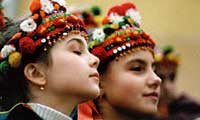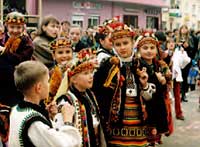Ethnography treasures
 Carpathian ethnographic region is divided into three main parts - Precarpathia, Carpathian Mountains and Transcarpathia. For a long period of time, being a part of other countries, Ukrainians preserved their ethnographic culture, although there was some interference with Slovaks, Hungarians and Poles. Inhabitants of mountainous regions of the Carpathians kept the most archaic cultural features, which differ from the culture of woodlands.
Carpathian ethnographic region is divided into three main parts - Precarpathia, Carpathian Mountains and Transcarpathia. For a long period of time, being a part of other countries, Ukrainians preserved their ethnographic culture, although there was some interference with Slovaks, Hungarians and Poles. Inhabitants of mountainous regions of the Carpathians kept the most archaic cultural features, which differ from the culture of woodlands.
There are such ethnographic groups in the Carpathian region - lemky, boiky and hutsuly. Lemky inhabit the territory of the both slopes of Beskyd, between San (Sian) and Poprad rivers, in Velykobereznianskyi and Perechynskyi districts. The first memories in written sources about lemky date back to VI century.
Boiky reside in Ivano-Frankivsk, Lviv and Transcarpathian regions. "Ruska Triytsia" - Markiyan Shashkevych, Ivan Vahylevych and Yakiv Holovatskyi - considered boiky to be the descendants of Celtic tribes. These tribes since VI century B. C. lived in the Central Europe and approximately in the 1st century A. D. moved to the Balkans. Archaeologists state that in the rivers Tysa, Dnister, Zakhidnyi Buh, Prypiat' and Dnipro basins, in Crimea there are signs of Celtic origin. As one can see, the territory of boiky is also marked with Celtic signs.
Hutsuly inhabit Ivano-Frankivsk, Chernivtsi and Transcarpathian regions - mostly in Rakhiv district. In XVII-XVIII centuries there were many "opryshky" - rebels, folk avengers. Volodymyr Shukhevych wrote: "The way of life, traditions and customs of hutsuly differ from other people living in the Carpathians and farther to the West".
 The uniqueness of hutsul's culture becomes the reason for the hypotheses of their descent from Caucasians which mixed with Ukrainians. Volodymyr Sichynskyi finds in the hutsuls' architecture quite a lot common features with heritage of the ancient Etruscans. Archaism of the ancient hutsuls' building reflects in the typical closed yard - it was a kind of fortress with gate and wicket. Each hutsul's house resembles a peculiar museum of folk art - all items of everyday life (crockery, furniture, carpets, clothes and weapons) are decorated with different traceries, carving, embroidery and paintings.
The uniqueness of hutsul's culture becomes the reason for the hypotheses of their descent from Caucasians which mixed with Ukrainians. Volodymyr Sichynskyi finds in the hutsuls' architecture quite a lot common features with heritage of the ancient Etruscans. Archaism of the ancient hutsuls' building reflects in the typical closed yard - it was a kind of fortress with gate and wicket. Each hutsul's house resembles a peculiar museum of folk art - all items of everyday life (crockery, furniture, carpets, clothes and weapons) are decorated with different traceries, carving, embroidery and paintings.
Hoary Carpathians are definitely the most beautiful place in Western Ukraine. This land is covered with ancient myths and legends, lulled by the singing of trembits. It is a real treasury of the immemorial customs, tires, traditions and centuries-old cultural property of boiky, lemky and hutsuls.
It seems that everyone here is a skilled craftsman, brilliant and creative personality. Only these people could construct in the mountains such amazing wooden temples without a single nail. These temples are decorated with unique icons painted on glass. Many of these icons and sacred images depicted on wood are considered to be wonderful samples of naive painting and are preserved in the museum.
Artists of the European level, first of all icon painters had glorified native land with their masterpieces. Among them are Iow Kondzelevych, author of icons in the Church of Exaltation of the Cross in Maniava Cell and Ivan Rutkovych, his predecessor, author of icons in Zhovkva Temple.
This is a small part of inherited cultural wealth. Most of them are the fruit of flourished Christianity branch grafted on the deeply rooted tree of local pagan beliefs. They live in our genetic memory, ring in the archaic ornaments of folk embroideries; they echoed with ancient symbols of earth and water on carved hutsuls' plates and pottery; their reflections spark in the diversity of Carpathian beads necklace, pulsate in mysterious traceries of Easter eggs.
There is nothing casual here - the curing power of mountains is accumulated and powerful mascots are hidden in their system of signs. No wonder that each visitor of the picturesque Carpathian land wishes to get some amulet not only as a souvenir but also for the good luck and sound health. For example, shaggy "lizhnyk" (woollen blanket) is said to be a vivid interior decoration and cold remedy. Power of prosperity drawing is also ascribed to lizhnyk. In some Transcarpathian villages it is still preserved the tradition of spreading the lizhnyk before bridegroom and bride meaning wealth and happiness.
Good and positive energy also has clothes made according to lizhnyk technique. Such "second life" to ancient weaving gave the masters of Kosiv State Institute of Applied and Decorative Art. Who knows, may be in the future their models made in hutsuls' ethnic style will gain the recognition in the world of high fashion?
Today, as hundreds years ago, women decorate their clothes with colourful embroidery. There are traceries from Bukovyna, Zakarpattia, Pokuttia: Each of them is unique and original. All together they look like a vivid flower garden which blossoms with rainbow patterns of shirts, towels and cushions. Their tunes have something in common with beads necklace - elegant beads decoration. Women in Western Ukraine pass from generation to generation the secrets of this decoration manufacture
From grandparents to children the ancient art of "pysankarstvo" - Easter eggs ritual paining - is passed. It is said that "pysanka" is very helpful in different situations - their signs and symbols attract to people love, health and prosperity; give to the earth and cattle fertility.
Quite a lot of good wishes are encoded in the local pottery - generously painted pots and plates, tiles and toys known as "zozulka" (cuckoo). There is something ancient in these small clay playthings. They breathe with the same mystery as trypilian figures of animals made by the unknown masters long time ago. (Trypilska culture belongs to the epoch of transition from late Stone Age to the Bronze Age lasting from III to II millenniums B. C. Bearer of this culture were the tribes, which inhabited the territory from the river Dnieper to the Carpathian Mountains. The culture was named after the village of Trypillia near Kyiv where during the archaeological excavations the fragments of this culture were found.)
Traces of the ancient pagan rites can be found today in beautiful and bright customs - celebration of the mysterious Rakhman Easter, fire purification in the night of St. John Baptist's Day: Like in the remote past people sing and dance fiery dance "kolomyika", awake the Carpathian Mountains with the sounds of trembita and pipes; speak with the Universe with the aid of drymba. They carve odorous wood with ancient cryptography of the tracery, paint Easter eggs and build temples. These are temples of soul of generous and talented nation.
Trembita is the biggest wind instrument in the form of conic wooden pipe without side openings. Its length is 4 meters. It is popular mostly on territory of Hutsul land and Bukovyna. In Biokivschyna it is still used to give the signal about the important event in the village. The diapason of trembita is up to 2,5 octaves, range of audibility is more than 10 kilometres.